Cheap Digital Cameras for Kids:
The Dakota "Single Use" Cameras
John Peterson, January 2004
contact102 at saccade . com
Update June-2007
Last summer, Ritz Camera and a few other photo dealers came
out with "single use" digital cameras. Ritz calls their
model the "Dakota". Trying to emulate the film-based
single use cameras, the idea was you'd buy the camera, take pictures
until it fills up, and return it to Ritz for "processing".
They unload the photos, make prints from them and sell you the
prints for more money. The camera is refurbished, repackaged and
sold again.
When I first heard of this I wrote it off as a pretty silly
way for a traditional film developer to try and hang onto their
dwindling photo-finishing business. After all, the big advantage
of digital photography is you don't need to make a trip to the
mall to get your pictures back, and you don't pay for pictures
you don't want. Even a $250 digital camera can pay for it self
pretty quickly with savings over buying film, developing and prints.
A couple months ago, Slashdot ran an article
describing how to tap into the Dakota "single use" camera
so anybody with an ordinary PC could get the pictures out of it
and re-use the camera. Being just before Christmas, the light
clicked on: they'd make great gifts for our four year old twins.
Normally I wouldn't turn kids that young loose with real cameras,
but at $11 per camera this wasn't a huge risk. Having taken one
apart, I'd estimate from looking at the parts inside that a Dakota
would sell for at least $50 if it were a typical consumer electronics
item. But I'm more than happy to let Ritz's questionable business
model subsidize our kid's Christmas.
Of course, the Dakota doesn't just plug right into your PC
and work with standard software. It took some pretty dedicated
reverse engineering to figure out how to talk to the camera and
write programs to extract pictures from it. The technical details
are found at the following sites by the people who did the hardware
decoding and software development:
All of these sites have lots technical info about the camera's
internals, details on how to wire them up to a standard USB port,
and links to additional sites about them. In order to use the
Dakota you need an adapter to connect the camera's proprietary
connector to a standard USB port. Fortunately I had an old Palm
Pilot cradle with a connector that fit the camera perfectly.
Rather than tear up a good USB cable, I decided instead to build
an adapter to connect a standard USB "B" plug (what
you normally connect to your scanner or printer) to the special
connector the Dakota uses. For the USB socket, I desoldered the
jack off of an old "USB Multiplexer" device. Everything
was assembled on a small chunk of perfboard as detailed below:
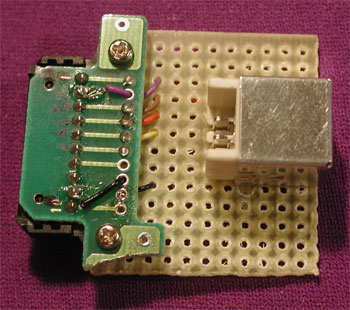
Most of the wires from the original Palm cradle cable could be
used, with a couple extras soldered on. |
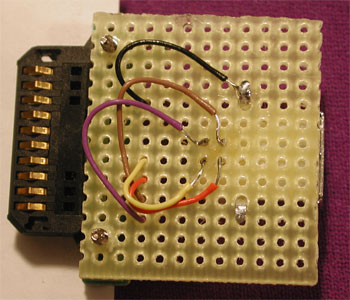 The leads on the USB socket are
quite short, which made soldering them a bit tedious. The leads on the USB socket are
quite short, which made soldering them a bit tedious. |
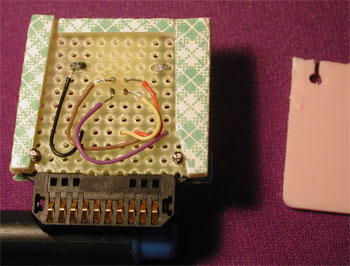
To protect the wiring I carved the battery door from a discarded
toy to fit the back with an Xacto knife, and attached it with
double-sided foam tape. |
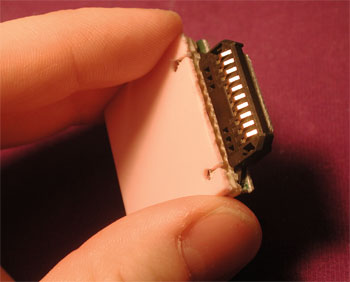
Finished adapter, in use with the camera below. |
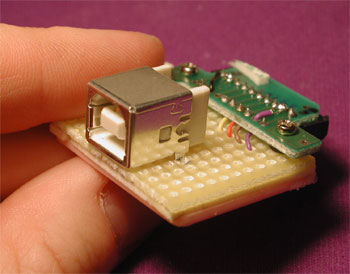 |
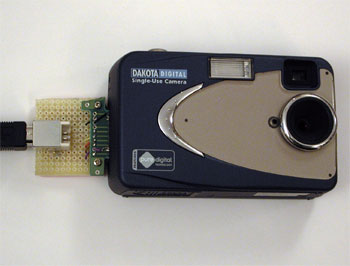 |
The one megapixel pictures from the Dakota aren't great, but
they aren't terrible either.With a bit of occasional color correction
in Photoshop they make decent 4x6 prints. I got an extra camera
for my wife to keep in her car, for those moments when something
interesting happens and the "real" camera is left at
home.
A couple of additional quirks about the cameras: They're only
available at the Ritz/Wolf retail stores. Ritz doesn't seem to
sell them via the web or phone. My guess this has something to
do with getting you back to the store to get your prints "processed".
Also, after using the software mentioned above to reset the camera,
I've found its necessary to take the batteries out for a minute
or two before the flash will work again. I'm not sure why.
So what sorts of pictures do four year olds with new cameras
take?
Its funny how many basics of photography - hold the camera
still, don't get too close, don't put your thumb in front of the
lens, etc - you don't think about until you see the kids use a
camera for the first time. There are other lessons too; learning
to read the "pictures remaining" display on the back
of the camera is a useful lesson in counting and numbers. So far
I'd call it a success.
Update June
2007
The cameras (some now with LCD picture preview screens)
have been updated to a new "PV2" model. Unfortuntely,
these have proven less easy to tap into (I guess the camera stores
wised up...). For more information, see the pages by Maushammer
and CEXX.
I suspect the "take it back to the store" digital cameras
aren't long for this world. "Cheap" cameras with removable
memory cards are around $70 or so; when they cost less than $50
the price advantage isn't there. And of course, every phone
has a camera in it these days.
Speaking of phones, one idea for a cheap kid's camera is to
find an "old" camera phone on eBay that's compatible
with BitPIM (to unload the
pictures). As the prices fall on eBay, I'd expect camera phones
to hit the sub-$25 range. A megapixel camera phone is easily in
the same quality league with the Dakota cameras, and has a nice
rechargable battery too.


 The leads on the USB socket are
quite short, which made soldering them a bit tedious.
The leads on the USB socket are
quite short, which made soldering them a bit tedious.






